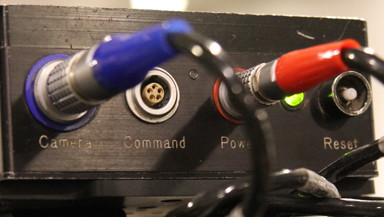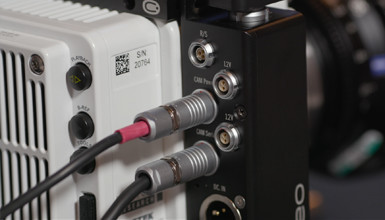[nggallery id=6]
Here are some of the technical details of this unit:
- Contains 12 volt to 24 volt upconverting circuitry to utilize common 12 volt power supplies/batteries
- Provides two of each 12 volt and 24 volt accessory power ports (1 Amp max. on each 24 volt port)
- Splits off the trigger signal to a common BNC connector
- Allows hot swapping of the 12 volt inputs
- Allows for integration of the Phantom Handheld Rig
(Stay tuned for details on this Abel-designed rig, which will be available shortly after NAB.)
Phantoms are 24 volt cameras, but with the predominance of 12 volt power supplies and batteries on the market, upconverting the voltage makes a lot of sense. The small design envelope of the Phantom body didn't allow the manufacturers much room for accessory power ports, so the box contains two each of 12 volt and 24 volt for zoom/focus motors, small monitors, etc. The 12 volt ports are pass through and use the fuses in the batteries for protection, while the 24 volt accessory ports have self-resetting fuses internally. We also decided to simplify the run/stop interface of the camera by splitting off the trigger signal from the capture signals (timecode, sync, strobe, etc.), allowing the use of a simple BNC trigger switch. As with most Digital Cinema cameras, the Phantom HD/65s take a short time to 'boot up'. So, we included two 12 volt inputs--one an XLR4 and one a Fischer 2-pin 103 series connector. These two inputs are 'hot swappable'--exactly what you want when you need to switch out a battery, but don't want to go through a time consuming shut down and start sequence. This is particularly useful for when the camera is fitted with the Abel-designed Handheld Rig or for when it is mounted on a Steadicam.
We also paid a great deal of attention to the aesthetics of the Breakout Box. Our design goal was to make the box fit seamlessly on the camera--so it would actually look like it was always a part of the system. I started out with some sketches and machined a Delrin mock up for the first round of design choices, which then evolved into a full-blown 3D SolidWorks model and the final matte black/white laser-etched product you see here.
The Breakout Box is supplied with Capture and Power cables, and Abel offers custom cable building for your accessories.
Note to current Phantom owners: If you have an older Phantom, please check to see that you have the revised bottom panel on the camera -- the updated panel has a 1/4-20 hole that is required to mount the Breakout Box.
The camera on the left has the revised bottom panel.















